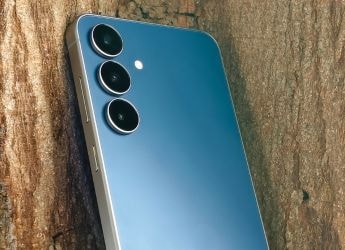- Home
- Science
- Science News
- Are We Alone? Study Redefines Conditions Take Make a Planet Habitable
Are We Alone? Study Redefines Conditions Take Make a Planet Habitable
The research team is the first to combine 3D climate modelling with atmospheric chemistry to explore the habitability of planets.

Photo Credit: NASA/ JPL-Caltech/ R. Hurt (IPAC)
Illustration of exoplanet LHS 3844b, which is 1.3 times the mass of Earth
A team of US researchers has redefined the conditions that make a planet habitable by taking the star's radiation and the planet's rotation rate into account - a discovery that will help astronomers narrow down the search around life-sustaining planets.
The research team is the first to combine 3D climate modelling with atmospheric chemistry to explore the habitability of planets around M dwarf stars, which comprise about 70 percent of the total galactic population.
Among its findings, the Northwestern team, in collaboration with researchers at the University of Colorado Boulder, NASA's Virtual Planet Laboratory and the Massachusetts Institute of Technology, discovered that only planets orbiting active stars -- those that emit a lot of ultraviolet (UV) radiation -- lose significant water to vaporisation.
Planets around inactive, or quiet, stars are more likely to maintain life-sustaining liquid water.
The researchers also found that planets with thin ozone layers, which have otherwise habitable surface temperatures, receive dangerous levels of UV dosages, making them hazardous for complex surface life.
"It's only in recent years that we have had the modeling tools and observational technology to address this question," said Northwestern's Howard Chen, the study's first author.
"Still, there are a lot of stars and planets out there, which means there are a lot of targets," added Daniel Horton, senior author of the study. "Our study can help limit the number of places we have to point our telescopes".
The research was published in the Astrophysical Journal.
Horton and Chen are looking beyond our solar system to pinpoint the habitable zones within M dwarf stellar systems.
M dwarf planets have emerged as frontrunners in the search for habitable planets.
They get their name from the small, cool, dim stars around which they orbit, called M dwarfs or "red dwarfs".
By coupling 3D climate modelling with photochemistry and atmospheric chemistry, Horton and Chen constructed a more complete picture of how a star's UV radiation interacts with gases, including water vapor and ozone, in the planet's atmosphere.
Instruments, such as the Hubble Space Telescope and James Webb Space Telescope, have the capability to detect water vapor and ozone on exoplanets. They just need to know where to look.
"'Are we alone?' is one of the biggest unanswered questions," Chen said. "If we can predict which planets are most likely to host life, then we might get that much closer to answering it within our lifetimes."
Get your daily dose of tech news, reviews, and insights, in under 80 characters on Gadgets 360 Turbo. Connect with fellow tech lovers on our Forum. Follow us on X, Facebook, WhatsApp, Threads and Google News for instant updates. Catch all the action on our YouTube channel.
Related Stories
- Samsung Galaxy Unpacked 2025
- ChatGPT
- Redmi Note 14 Pro+
- iPhone 16
- Apple Vision Pro
- Oneplus 12
- OnePlus Nord CE 3 Lite 5G
- iPhone 13
- Xiaomi 14 Pro
- Oppo Find N3
- Tecno Spark Go (2023)
- Realme V30
- Best Phones Under 25000
- Samsung Galaxy S24 Series
- Cryptocurrency
- iQoo 12
- Samsung Galaxy S24 Ultra
- Giottus
- Samsung Galaxy Z Flip 5
- Apple 'Scary Fast'
- Housefull 5
- GoPro Hero 12 Black Review
- Invincible Season 2
- JioGlass
- HD Ready TV
- Laptop Under 50000
- Smartwatch Under 10000
- Latest Mobile Phones
- Compare Phones
- Huawei Nova 15
- Huawei Nova 15 Pro
- Huawei Nova 15 Ultra
- OnePlus 15R
- Realme Narzo 90x 5G
- Realme Narzo 90 5G
- Vivo S50 Pro Mini
- Vivo S50
- Asus ProArt P16
- MacBook Pro 14-inch (M5, 2025)
- Huawei MatePad 11.5 (2026)
- OnePlus Pad Go 2 (5G)
- Huawei Watch 10th Anniversary Edition
- OnePlus Watch Lite
- Acerpure Nitro Z Series 100-inch QLED TV
- Samsung 43 Inch LED Ultra HD (4K) Smart TV (UA43UE81AFULXL)
- Asus ROG Ally
- Nintendo Switch Lite
- Haier 1.6 Ton 5 Star Inverter Split AC (HSU19G-MZAID5BN-INV)
- Haier 1.6 Ton 5 Star Inverter Split AC (HSU19G-MZAIM5BN-INV)

















